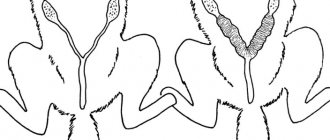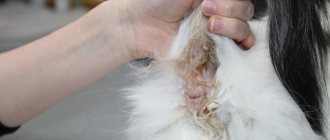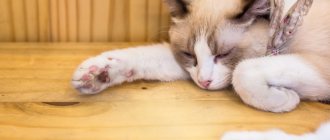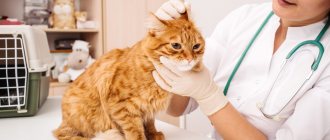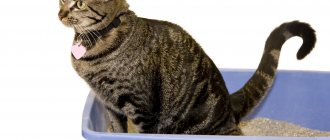The inflammatory process that develops in the area of the mucous membranes lining the vagina is called vaginitis. Vaginitis in a cat develops as a result of the activation of pathogenic bacterial microorganisms. It occurs more often in females who have not given birth than in females who have given birth.
Cats that have not had experience of childbirth suffer from juvenile vaginitis, which goes away on its own with the onset of the first sexual heat. The main cause of juvenile vaginitis is the increased production of a specific secretion by the vaginal glands with the further addition of pathogenic microflora.
In cats that have undergone sterilization, an atrophic type of vaginitis is diagnosed against the background of a sharp deficiency of estrogen and a decrease in immune status.
Signs of the development of an inflammatory process in the mucous membranes of the vagina include purulent discharge from the loop, a feeling of itching, constant licking of the genitals, and an increase in body temperature.
Types of disease
According to the nature of the inflammatory process, serous, catarrhal-purulent, diphtheritic, and phlegmonous vaginitis are distinguished.
Based on the causes of occurrence, the following types of vaginal inflammation are classified:
- Primary - occurs as a result of mechanical damage during lambing or mating, as well as low concentrations of estrogen after castration or at a young age, before the gonads begin to function.
- Secondary - is a symptom of infectious diseases, primarily brucellosis, as well as sexually transmitted infections due to accidental mating or mating with an infected cat.
According to the speed of appearance of clinical signs, acute and chronic vaginitis are distinguished.
Description of the disease
Vaginitis or colpitis is an inflammation of the mucous membrane of the animal’s vagina. This is a disease that is quite common in cats.
The causes of the disease may be:
• bacterial or viral infections (for example, herpes): chlamydia, tumor, genitourinary tract infections, trichomoniasis, vibriosis; • mechanical or chemical damage (occurs less frequently): injuries, unsuccessful mating, unqualified “assistance” during childbirth.
Classification depending on exudate:
• serous – ulcers appear on the surface of the vagina with slight discharge of a cloudy and transparent color; • catarrhal-purulent – the fur in the tail area sticks together, sheds, inflammation appears on the skin in the vaginal area, and the discharge has an unpleasant odor, viscous, cloudy with a yellow-white color; • phlegmonal – increased irritability of the genital organs and an increase in their temperature, the formation of abscesses with subsequent discharge of pus; • diphtheric – this variety is very dangerous, the vagina is covered with a white film of fibrin, and when it is removed, deep ulcers and bleeding form.
Diagnosis and treatment
If vaginitis is suspected, the cat is examined, the medical history is taken into account, and the veterinarian prescribes a urine test, blood test, ultrasound, and colposcopy.
Conduct a rapid test for brucellosis. The form of the disease is established - serous, catarrhal-purulent, diphtheritic or phlegmonous. Pyometra and tumors are excluded. If serous or purulent-catarrhal vaginitis is diagnosed, douching is prescribed.
The following antiseptics are used:
- Chlorhexidine;
- Iodinol;
- Furacilin;
- chamomile decoction.
For diphtheritic or phlegmonous forms of vaginitis, it is practiced to insert tampons soaked in antimicrobial oil emulsions into the vagina. In severe cases, antibiotics are prescribed - Stomorgyl or Sinulox.
Abscesses and phlegmons are opened. If vaginitis occurs in a kitten, no treatment will be required. Pathological symptoms will disappear during the first heat. For estrogen deficiency that occurs in castrated cats, or ovarian hypofunction, hormonal drugs are used.
Prevention consists of proper nutrition, which maintains the immune system at the proper level. It is necessary to avoid accidental matings and mate females with proven males.
Diagnosis of the disease
During the appointment, the veterinarian examines the genital organs using vaginoscopy - an examination with a narrow endoscope. Thanks to it, the anterior wall of the vagina and cervix is examined, in this case the source of the discharge can be determined.
The doctor also performs a digital examination of the condition of the vagina. If a tumor is detected, a biopsy is performed. Next, a smear is taken from the walls of the vagina, on the material of which cytology and microbiological examination are carried out. Pus, blood or feces are taken for analysis. Purulent inflammation is most often characteristic of older cats. Greater keratinization indicates the degree of exposure to estrogen and determines the cat's pre-estrus or estrus phase.
The condition of the uterus is determined using an ultrasound of the abdominal cavity.
Blood and urine are taken for general and biochemical analysis. Most often, the results are normal, but an increased level of leukocytes in the urine is acceptable. The concentration of progesterone in the blood plasma is determined. Based on the results, it is determined whether the cat is in the inter-estrus period, when discharge is the norm. It is important to note that high levels of progesterone also indicate the occurrence of pyometra or pregnancy.
Pyometra is a dangerous form of purulent endometritis that affects cats at any age. It does not threaten only those who are sterilized (when the uterus and ovaries are removed).
A rapid test is carried out to determine brucellosis, a disease caused by the bacteria Brucella that affects the reproductive organs. The disease is transmitted to kittens and cats, any cat can get it, and it can also be transmitted to humans through close contact with a pet. Contrast colpography determines the presence of tumors or foreign bodies, vestibulo-, urethro- and rectovaginal strictures.
Prevention
To avoid unaesthetic manifestations, you must:
- provide Murka with proper living conditions (staying under fans, air conditioners, or in ventilated rooms is not recommended, getting wet in cold rain, or staying outside for a long time in sub-zero temperatures is not allowed);
- monitoring the behavior and well-being of your pet;
- comprehensive examination in the clinic for detection, including the listed diseases (twice a year).
If a cat has discharge in the anus area, the health of the pet should not be neglected. It is much easier to visit the veterinarian one more time than to lose a living creature due to your own negligence.
Sources:
https://allvetdrugs.ru/bolezni/vaginit/koshki-14/
https://med-vet.ru/stati/terapiya/vaginit-u-koshek/
https://saveirbis.ru/vaginit-u-koshki-lechit/#i-8
Types of discharge
Purulent vaginal discharge in a cat can occur for various reasons. Therefore, they are diverse and there is even a classification of them. Most of this discharge is very dangerous for the cat’s health, so you should always be careful about this disease. However, there are also reasons that cannot lead to serious illnesses.
In order to understand how serious and dangerous a pet’s discharge is, it is necessary to collect the clots and determine their nature. But this can only be done by a specialist; such an analysis can be carried out in a veterinary clinic. And only after this can the cause of the disease be more accurately determined and how it should be treated.
There are two types of cat discharge: dangerous and safe. Any purulent discharge requires treatment and the attention of a specialist. You should not treat your cat yourself, as this can only cause harm and aggravate the progression of the disease.
Causes
“Anti-sex” hormones as a cause of pyometra
There can be more than a dozen causes of pyometra in a cat, but the most important are two:
- problematic childbirth with trauma to the uterus, when microbes easily penetrate from the outside and multiply quietly in conditions favorable to them;
- frequent and uncontrolled use of hormonal drugs that block sexual desire (estrus).
You should know it! Progesterone, which is most often included in anti-sex pills or injections, promotes the secretion of secretions by the epithelial cells of the uterus. The liquid, unable to find a way out, accumulates and begins to rot under the influence of microorganisms.
Other less common, but nevertheless important factors in the occurrence of inflammation include:
- transition of the inflammatory process from other organs (vagina, ovaries);
- prolonged or difficult labor with the fetus remaining inside,
- violation of the principles of sterility during obstetrics,
- infectious processes affecting the reproductive system,
- violation of feeding and living conditions of pregnant females.
Important! In a chronic animal with low resistance and a weak immune response, the risk of inflammation increases significantly.
Symptoms and first signs of inflammation of the uterus in a cat
Most often you can notice the following symptoms and first signs of inflammation of the uterus in a cat:
- In severe forms of inflammation (i.e. purulent endometritis), the general condition of the pet sharply worsens, the cat refuses food, but drinks a lot.
- A sharp and sudden increase in general body temperature is possible, and fever of a constant or intermittent type is also characteristic.
- Under the animal’s tail, you can easily see “surges” of dried or fresh exudate; in these same cases, the cat begins to smell bad, and the pet leaves stains of an unpleasant appearance and smell on linen and clothes.
- The pet constantly licks the genital area.
- In severe cases, the cat’s stomach is very tense and painful, the animal meows pitifully and angrily.
- A long course, as well as chronic forms of endometritis, are fraught with the development of exhaustion and dehydration.
Orchitis in dogs and cats
Orchitis in dogs or cats is inflammation of the testicles and their appendages (epididymitis). It can be one-sided or two-sided. Occurs due to injury, infection of the genitourinary tract or prostate.
Symptoms of orchitis
Clinical signs of acute orchitis:
- swelling, hyperthermia, severe pain of the affected testicle;
- increased body temperature;
- pain when walking;
- stiffness of gait;
- decreased physical activity;
- When the disease becomes chronic, the testes change in size - they increase inadequately or, conversely, atrophy; acquire a dense or loose-cystic structure. Acute orchitis threatens the occurrence of abscess and necrosis.
Causes of dangerous discharge
Dangerous purulent discharge in a cat always requires treatment and careful attention. There are several reasons for their occurrence. First of all, these are any types of infections, as well as various inflammations, cancer and other equally serious causes.
A pregnant cat always requires special attention, as complications may arise during childbirth, in which case part of the placenta remains inside the animal. Most often, purulent vaginal discharge in a cat indicates that the process of decomposition has begun in its body. To cure a sick animal, surgery is necessary.
Another reason may be an infectious disease of the genitals. If a cat has purulent discharge with a reddish tint, then most often this indicates that pathogenic processes are occurring in the animal’s uterus or in its bladder. They are easy to distinguish, since then such secretions do not have any odor, but are characterized by a peculiar and thick consistency. As soon as such signs appear in a cat, you should immediately contact a veterinarian.
Purulent discharge from a cat's loop, the treatment of which requires special attention, can also occur with cancer.
You should always pay attention to the smell of the discharge. Thus, a cat’s purulent discharge from the loop (vagina) has a peculiar smell, which will indicate that destructive processes are taking place in the cat’s body.
The cause of discharge with pus can also be inflammatory processes of the mucous membranes. You should carefully monitor your cat's behavior, as at this time she becomes restless and even aggressive. Can lick itself often and for a long time. Such a cat will be reluctant to go to the toilet, so it will show aggression and behave anxiously. This is due to the fact that she experiences pain when urinating.
If there was an injury to the bladder or uterus, then the cat may also have purulent discharge. Any injury to an animal will be accompanied by discharge, so the owner must provide it with immediate medical attention.
Symptoms
The disease has 3 forms. The greatest danger of them is the hidden one, due to which the animal’s condition deteriorates very slowly, and symptoms appear only at the last moment, when the uterus is close to rupture, and it is almost impossible to help the pet.
Another form of inflammation, in which the cat’s uterus has an open cervix, is not so dangerous, since it cannot lead to the death of the animal in 1-2 days. However, this does not mean that the cat can do without therapy. If the animal's condition is left unattended, its death will occur within 1-2 weeks. Only sometimes there are cases when a very strong cat can live up to 3 weeks. With this pathology, the animal experiences the following symptoms of uterine inflammation :
- discharge of pus from the genital fissure (vagina);
- the cat licks the external genital area excessively;
- dark brownish spots where the cat sleeps;
- complete loss of appetite;
- elevated temperature;
- The cat drinks a large amount of liquid.
Every day the pet's condition worsens. The volume of purulent discharge increases, the uterus constantly pours out pus, and the cat no longer has time to wash it off, which makes it noticeable not only on the bedding, but also on the fur around the genital opening.
© shutterstock
Another form of the disease, which occurs when the cervix is closed, is rapid, and if the cat does not receive urgent treatment, then it dies after 2, maximum 3 days because the uterine lining ruptures. This occurs because the uterus is overfilled, since due to its closed cervix, pus does not flow out. When a rupture occurs, its contents spill into the abdominal cavity, causing peritonitis. Symptoms of the disease are :
- drops of pus on the genitals or their complete absence while simultaneously observing other symptoms that the uterus is inflamed;
- a rapid increase in the volume of the abdomen - it suddenly becomes tight and painful, as the uterus is filled with pus. The increase disappears before our eyes and sometimes in just a few hours;
- rapid rise in temperature;
- complete refusal to eat;
- drinking particularly large amounts of liquid;
- intense diarrhea - does not always occur;
- frequent, scanty urination - due to the fact that the uterus is very enlarged, even a small amount of urine causes a sharp increase in pain and leads to the fact that the cat strives to immediately empty the organ;
- severe apathy;
- very heavy breathing;
- the cat completely loses its reaction to any external stimuli.
Usually the disease begins to manifest itself 1-2 months after inflammation begins to develop. During this time, bacteria manage to multiply in sufficient quantities in the uterine cavity, where favorable conditions are constantly present for them, if local immunity does not work.
The uterus can also become inflamed while the cat is pregnant. In such a situation, it is impossible to save the kittens, and they die. With timely treatment, the cat itself can survive the inflammation, but since the uterus will be surgically removed, the female will lose the ability to give birth to kittens.
Causes of vaginitis in a pet
Vaginitis in a domestic cat can develop for a variety of reasons. The primary disease is most often caused by the following factors:
- Penetration of a viral or bacterial infection into the genitals. This can happen during childbirth, due to injury or unsuccessful mating.
- Features of the structure of the vagina. In some individuals, there is a bending of the vagina, which contributes to the occurrence of stagnation and provokes the development of pathogenic microflora.
- Presence of a tumor.
- Poor nutrition, which leads to disruption of the intestinal microflora, which negatively affects the condition of the vaginal mucosa.
If vaginitis develops as a result of another disease, it is considered secondary. Sometimes the root cause of inflammation of the vaginal walls is diseases such as trichomoniasis and vibriosis. In this case, it is first necessary to treat the underlying disease, and only then begin to treat vaginitis.
Treatment of white discharge in cats
If leucorrhoea is accompanied by an unpleasant odor, this is a reason to contact a veterinarian. After a clinical examination and laboratory tests, the doctor assesses the general condition of the cat and prescribes treatment. prescribes treatment.
With timely treatment, it is possible to use conservative therapy methods. Vaginitis or open pyometra is treated with douching. The cat owner should ask a veterinarian or experienced felinologist how this is done.
Medicines based on furatsilin or chlorhexidine are taken into a rubber syringe and carefully squeezed into the vagina. At the same time, oral antibiotics or sulfonamides are prescribed.
The radical method of treatment is castration. Indications: closed pyometra, cancer, age over 6 years. In Russia, castration is called sterilization, although these are different operations.
Residents of high-rise buildings get a cat, but do not know what to do with it when it reaches sexual maturity. The call of nature, not supported by mating, causes torment for the pet and those around her. A reliable way to prevent it is to remove the uterus with ovaries and appendages at 8-10 months.
In this case, the cat will never have white or differently colored discharge from the loop. The disadvantage is the need to use expensive specialized food for sterilized cats to avoid obesity.
Treatment of inflammation
Mild or initial forms of the disease (serous or catarrhal-purulent) usually do not require antibiotics. In these cases, douching with the following drugs is recommended:
- Iodinol. It is important to use a solution rather than a concentrated product. Take one tablespoon of the drug per glass of water.
- Soda. A simple and effective remedy that can be used to treat mucosal irritation. Stir a teaspoon of baking soda into 200 ml of warm water.
- Potassium permanganate (potassium permanganate). Dilute several crystals of the substance in a glass of liquid, achieving a soft pink tint of water.
- Furacilin. Dissolve one tablet of the drug in 100 ml of hot water. Cool to 40 degrees before use.
- Hydrogen peroxide. Use a 3% solution, diluting it with water in a ratio of 1:3.
- Chlorhexidine. An excellent bactericidal agent that will help suppress the growth of pathogenic flora. The drug is administered into the vagina in 2-3 ml doses, using an original bottle equipped with a special tip. Miramistin has similar properties.
- Camomile tea. 2 tbsp. l. dried flowers need to be poured with 200 ml of hot water and left in a water bath for 40 minutes. Strain before use.
For the procedure, you can use a rubber syringe with a volume of 30–60 ml. Pour the medicinal mixture, heated to 40–45 degrees, into the device. Insert the tip, lubricated with Vaseline, into the animal’s vagina 0.5 cm. Pressing the bulb, inject the liquid, which will begin to pour out as it accumulates. At first the water will be cloudy, gradually becoming clear.
The procedure is carried out 1–2 times a day. Before use, the syringe should be sterilized (boiled).
If your pet is diagnosed with phlegmonal, purulent vaginitis, in addition to douching, the doctor may prescribe antibiotics. The most commonly used are Metronidazole (Metrovagin, Klion), Amoxicillin. The tablet is placed on the side of the tongue, as deep as possible. If the drug is prescribed as an injection, the injections are given subcutaneously - in the side fold or withers. Taking antibacterial agents is indicated in case of diphtheritic vaginitis; douching is not performed.
To speed up the healing process for phlegmonal and diphtheritic types, the veterinarian can prescribe various ointments that must be applied to the visible parts of the genital organs. Prednisolone, syntomycin, streptocidal, oxycort, gramicidin ointments, and Vishnevsky's liniment are used. The ulcers are cauterized with a 3–5% lapis solution. It is important to ensure that the cat does not lick itself after using such drugs for 2-3 hours.
Treatment of pyometra
If a cat is diagnosed with pyometra, drug therapy may be prescribed, but a more effective way to get rid of the problem is surgery.
The advantage of conservative therapy is that the animal retains the ability to bear offspring.
Drug therapy
Medicines can only help with the open form of the pathology, and even then not always. With this treatment there is a risk of relapse. Complex therapy for inflammation is aimed at removing purulent masses, getting rid of bacteria and increasing the body's resistance. Experts prescribe the following categories of drugs:
- Hormonal. Oxytocin or Prostaglandin are usually used - they cause the uterus to contract, which helps remove pus.
- Antibiotics. Brulamycin, Amoxicillin, Cloprostenol to get rid of pathogenic microflora.
- To enhance immunity. A specialist may prescribe Immunofan or Ribotan as immunomodulators.
If there are no positive changes, the doctor should insist on surgery.
Surgery
The surgical method, which involves removing the uterus and ovaries, is considered the most effective for ridding an animal of pyometra. The operation is performed under general anesthesia and if assistance is provided in a timely manner, the likelihood of a complete recovery is very high. In the case of a closed form of pathology, specialists, in most cases, immediately prescribe surgery.
Removing the uterus and ovaries is an effective way to get rid of pyometra
If the owner did not purchase the animal for breeding, then it is better to castrate it. This is the best measure to prevent the development of pyometra.

